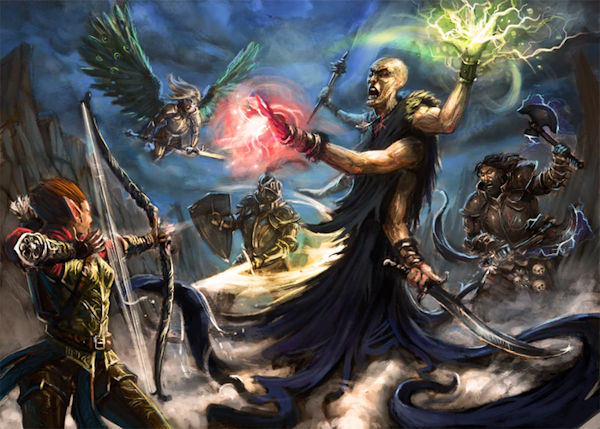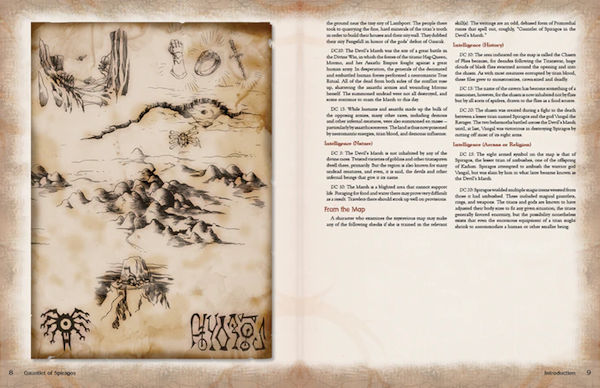 The Scarred Lands,
Player’s Guide was originally created at White Wolf before Onyx Path
Publishing and Nocturnal Media took it over. In a 2016 Kickstarter campaign,
Onyx and Nocturnal successfully funded both the Pathfinder and the 5th Edition
version, raising over $60,000 to make this book a reality. Thanks to Matt, from
Onyx Publishing for giving me this review copy! I had a great time reading
through the 314 pages of sheer adventure.
The Scarred Lands,
Player’s Guide was originally created at White Wolf before Onyx Path
Publishing and Nocturnal Media took it over. In a 2016 Kickstarter campaign,
Onyx and Nocturnal successfully funded both the Pathfinder and the 5th Edition
version, raising over $60,000 to make this book a reality. Thanks to Matt, from
Onyx Publishing for giving me this review copy! I had a great time reading
through the 314 pages of sheer adventure.
First thing I have to mention is how gorgeous the artwork is, so serious kudos to the art team. Vibrant colorings, unique character designs, and consistent themes play together nicely in the drawings within this player’s guide.
The first few chapters do really well in setting up Scarn, a world created by powerful titans. It goes over the scarred land setting, talking about the geography, the Divine War, the titans and the gods. Learning about the history of Scarn was fascinating, from the fall of the titans and rise of the gods, the destruction of mortals, and the death of some smaller gods in the process. How the lands of Scarn were basically decimated because of it. The book focuses mainly on Ghelspad, the most populated continent of Scarn and also the hardest hit during the Divine War. I also liked learning about the titans, like Gaurak (the Ravenous One), Kadum (Bleeding One), and Lethene (Dame of Storms). My personal favorite sits with none other than Golthagga of the Forge, the titan who manipulates the raw substances of the world. Super cool.

The first chapter also goes into the gods of the world too, for it’s best to have both sides of the coin for the players to choose from. The book goes over the major gods like Vangal (the Reaver), Tanil (the Archer), and Corean (the Avenger). From this list, my favorite is Enkili for this god is a shapeshifter and an enigma to the other gods and is often portrayed as a male and female.
The new races the players can choose from are created to be pretty hardy, hardier than other races in the Players Handbook mainly because Scarn is a difficult place to live. The races are given one or sometimes two extra racial features just to combat the difficult lifestyle, so keep that in mind if you want to use these special races in other campaigns. When you think of hardy races, dwarves often come to mind and it’s true with this campaign, too. Short, stocky, and a divine race, dwarves are loyal to the gods and some of them actually fought in the Divine Wars. Per the harsh landscape, the Charduni dwarves get things like the Charduni Combat Training where they have proficiencies with light hammers, war hammers, war scepter, and spike chain.
Other races include the Hollow Legionnaires (spirits of heroes bound to suits of armor), Ironbreds (horse-like creatures created by the titans), and Slitherin (ratfolk). From the new races, I’d have to say the Manticora are my favorite. Basically cat-people, the Manticora are nomadic people who admire storytellers. (And yes, perhaps I like this race because I love cats and I am also a writer? One may never know.)

But it’s the new class archetypes I’ve really fallen in love with. I play a cleric in my D&D campaign so, of course, I first flipped to the new cleric archetypes. I wasn’t disappointed. The Liberty Domain sounds badass, honestly. With a channel divinity called Be Free, the cleric can break free of bindings and as a bonus action you can give a creature within 30 feet of you freedom of movement. (This would be clutch in a battle.)
A unique trait that interested me for the barbarian class was the Path of the Tailfighter. It puts the tails of the Asaatthi and Slitherin to good use, essentially using them as lethal weapons. Though restricted to only those two races (unless the Game Mater/GM says otherwise), this path seems like a fun option for a player to take. The Sorcerer seems to have the most additions, though, with origins like Blessed Bloodlines (at 14th level you get wings, for goodness sake!), Elemental Kinship (where you can basically be descended from an element and can use that to your advantage), and the Titanic Corruption (which is exactly what it sounds like, a sorcerer is blessed or cursed by the titans and gets minor, major, and grand gifts because of it).
As with each new player’s guide, there are also original weapons, armor, and equipment. One interesting thing to note is that Scarn is low-tech so no firearms or explosives are in the guide, though the GM could include them if they so desire. Whipswords—which is exactly what it sounds like—seem like a fun new weapon for warrior to use. Icehammers—a heavy hammer with a curved pick on one end—also seem exciting!

You’ll have to look at all the fascinating spells within this campaign, but the biggest part is what’s called Mesos’ Bane. Basically, every arcane caster will have a bane effect spiraling from the Divine War. Though it’s mostly for flavor, the GM could also include major banes to have both a benefit and a drawback when using arcane spells.
As for the rest, you’ll have to read to find out. It goes over amazing magical items like magic tattoos, barbed mail, cloak of whispers, and sign of the owl. There’s a whole section on the continent of Ghelspad, diving deep into the history of the continent and the various regions it has, as well as the thriving and struggling nations. It’s the perfect place to read all about the cities and free nations and get into the lore surrounding the world. The book also goes into the groups and organizations the world has to offer, breaking it up into seven categories: Arcane, Criminal, Death, Devotional, Mercantile, Military, and Political. At the very end, the appendix talks about Titanspawn creatures that can be found on Scarn. (Spoiler, there’s a lot and they all look terrifying!)

Overall, there’s literally a whole world contained within these pages and I’m fascinated by all of it. This player’s guide has numerous amazing facets for the players to toy with, with just a touch of destruction and horror. Those who walk on Scarn, walk a dangerous path indeed.


